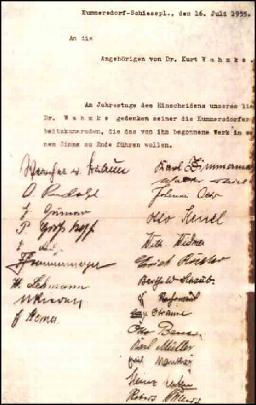Thiel’s professor in Breslau, Professor Ruff, recommended him to the institute of Erich Schumann at the University of Berlin. The institute focused on military research projects and worked very early on the development of rockets.
Continuing the work of Kurt Wahmke, who had been killed during rocket propulsion engine tests on July 16, 1934. Because of this, Thiel, together with his colleagues, signed an obituary for the relatives of Wahmke on the first anniversary of his death.

Obituary to the relatives of Kurt Wahmke, July 16, 1935
Thiel signed on right column, 2nd from top
(source: Dr.-Ing. O. Przybilski, private archive)
Thiels main projects at Schumann's institute:
Consulting on the development of a hydrogen peroxide engine at Walter Werke in Kiel.
Supervising of postgraduate student Seifert. He was working on the right choice and the right mixing ration of rocket fuels.
With his colleague Glimm Thiel initiated the project "Exploration of combustion in liquid-fuelled rockets". They developed the first concrete test stands at Kummersdorf-East, the institute's testing site.
Dornberger got to know Thiel at the
"Versuchsstelle Kummersdorf". In Kummersdorf-West Dornberger an his team,
e.g. Wernher von Braun and Klaus Riedel, were working on
Kummersdorf-West. The institute of Prof. Schumann used Kummerdorf-East
as an experimental base.
So, Dornberger got to know Thiel. Dornberger liked the way he worked, and he was
impressed by Thiel's skills. He asked Thiel to come to Kummersdorf-West. But before Thiel could start in 1936 he was called up for national service. He had to serve a short time, he did only about two months as a
radio operator in Magdeburg.